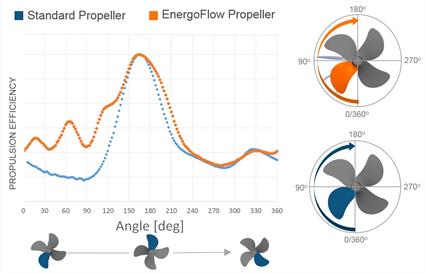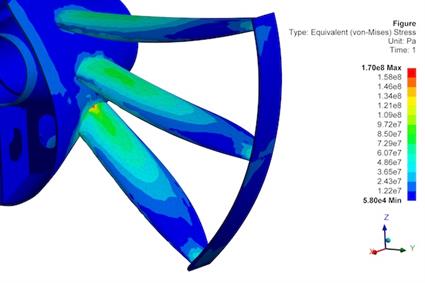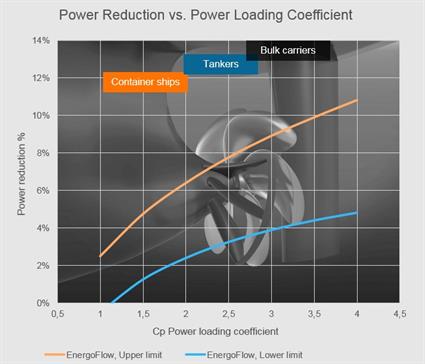

Wärtsilä launched its latest energy-saving device for ship engines, a next-generation pre-swirl stator dubbed the Wärtsilä EnergoFlow. The innovative apparatus, available for both retrofits and new-builds, is already raising eyebrows with the substantial fuel savings it can yield – up to 10% in certain cases. The key to its propulsion-boosting power is how it controls the complex hydrodynamics upstream of the propeller.
With cutting fuel costs such a high priority for ship operators, marine engineers are constantly looking for ways to squeeze the most propulsive power out of every bit of energy that goes into an engine. One way to do that is to dampen down the rotational losses that result from the way water flows into a ship's propeller blades.
Due to the shape of a typical ship's hull, the water leaving its aft flows steadily at a slight upward angle as it moves toward the propeller. At the downward stroke of the propeller, the 3 o'clock position when viewed from aft, this upward inflow angle is ideal since the blades are moving against it and can thus better accelerate the moving flow. On the opposite side of the propeller, however, both the water and the blade are moving upward, minimising the propeller's ability to push against the water and thereby weakening overall propulsion power.
This situation can best be compared to an airplane with head-or-tailwind during takeoff. In case of a tailwind, the lift of the wings is reduced, thereby elongating takeoff distance.
To counteract this effect, engineers over a decade ago began experimenting with the idea of a pre-swirl stator (PSS), a static structure consisting of multiple fins attached to the ship's hull that were designed to shift part of the wake downward for a better angle of attack. Though the basic theory behind the PSS was sound, early examples on the market couldn't effectively control the water's flow direction and weak structural design left them prone to cracking or breaking off at the first sign of rough weather.
Designs soon improved, however, and the PSS eventually gained enough interest to be chosen for study by GRIP (Green Retrofitting through Improved Propulsion), an EU-funded research project carried out from 2011 to 2015 to investigate various energy-saving options in the marine market. Wärtsilä and the nine other European companies participating in GRIP put the PSS concept under their collective microscope and, after gaining a deeper understanding of the hydrodynamic principles involved, came up with a better working model. In sea trials on a bulk carrier, GRIP's PSS achieved a power savings of 7%.
Modelling the fins
To build on the successes of GRIP and develop the Wärtsilä EnergoFlow, Wärtsilä's engineers had to design a model with three fundamental traits: it had to be robust enough to withstand both long-term fatigue and the roughest weather, optimise the flow into the propeller to maximise propeller efficiency, and minimise viscous resistances. Also, applying a PSS can lead to additional hull and rudder resistance, which can result in considerably less net gain. This factor had to be addressed as well.
The failsafe design of the Wärtsilä EnergoFlow was achieved by both taking into account fatigue – the low-level stresses that occur over the lifetime of a ship – and carefully studying the effects of peak load, or the maximum stresses that a ship might encounter once every 25 years. For the latter, Wärtsilä used a modelling technique that treated the Wärtsilä EnergoFlow's fins as if they were a propeller blade attached to the ship, then looked at the stress effects of various wave heights combined with the ship's vertical motion, sailing speed, pitch, roll and other factors. Once the requirements were fully understood, designers were able to adjust the fins' thickness, width, length and camber accordingly to create a product with a 25-year lifetime. They also added a ring, or arched segment that connects the fins at their tips, which serves to distribute the force that might act on any one fin under an extreme condition such as slamming, when the ship's aft repeatedly rises out of the water. Model tests carried out to measure forces in both normal and storm conditions found that he ring decreases the maximum occurring stress on each fin by about 40%.
For fine-tuning the pre-swirl flow and lowering viscous resistance, Wärtsilä relied on the latest CFD modelling to create its design. The result can be seen in the pronounced curvature of the fins in the Wärtsilä EnergoFlow.
But it's important to note that the Wärtsilä EnergoFlow concept is about more than the design of the stator itself, since it's the hydrodynamic interplay between the stator, the hull and the propeller that will ultimately determine how accurately the flow can be directed and how much viscous resistance will be added. Therefore, the positioning of the stator and the design of the propeller are critical parts of the package and are key elements in the power savings equation.
Custom-designing solutions
As every ship design and operating profile is unique, Wärtsilä assesses each one individually using CFD modelling to create a strategy for installing the Wärtsilä EnergoFlow. The stator itself is custom-designed for each case, with possible variations in the shape of the fins and, in some circumstances, even the number of fins when the typical three-fin approach isn't the best solution.
Hull integration must be carried out by a welded connection to the cast bossing or stern tube to ensure structural soundness. Sometimes this can result in limited options for optimizing the positioning of the stator relative to the propeller, but Wärtsilä engineers can usually find a solution even within these constraints.
The most crucial factor in the Wärtsilä EnergoFlow setup, however, is propeller pairing. The system works best when a ship's propeller is specifically designed to work with the PSS – a factor than can boost the power savings by up to 2%. Wärtsilä has the capability to modify an existing propeller by removing pieces at the trailing edge to give it a new pitch angle, but in cases where the resulting fuel savings would be large enough, it would make sense for a ship owner to invest in a new propeller.
Just how much power – and therefore fuel – savings can be achieved is again determined by the specifics of each case, but there are some generalities based on ship type. Bulk carriers, for instance, can see fuel savings in the 10% range. Container ships, which are already relatively efficient in propulsion terms, would still see a respectable 4% improvement, but this could also climb to 10% if a new propeller design for slow steaming applications is made. The savings figure for tankers falls roughly in the middle of the two.
Regardless of the ship type, the Wärtsilä EnergoFlow typically pays for itself within 1 to 2 years of operation. Given the high potential for savings and short payback times – not to mention the environmental benefits of burning less fuel – this could be a true game-changer for ship owners.






